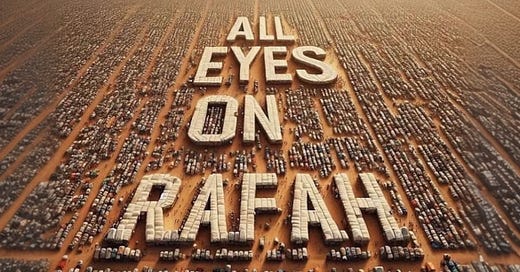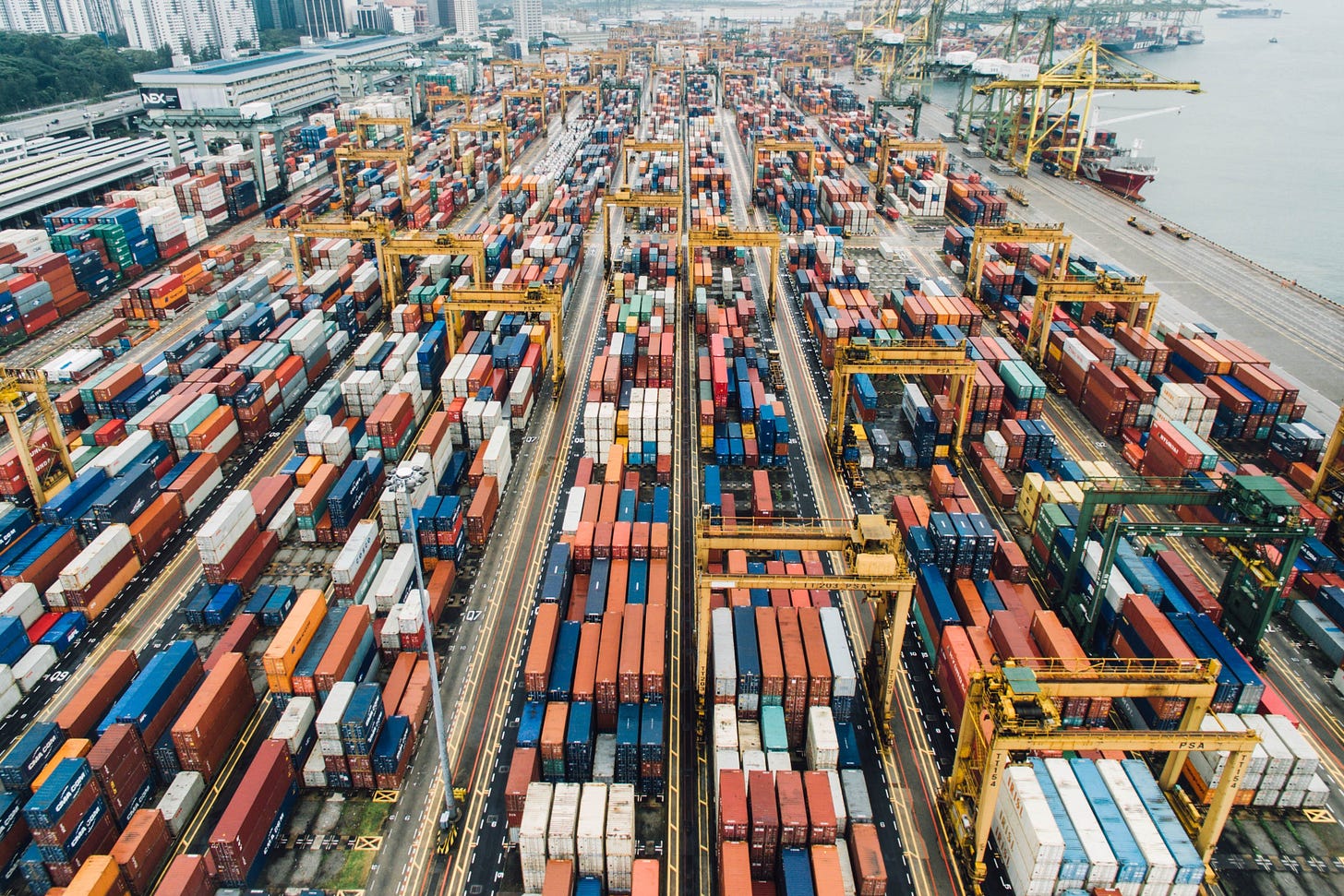This may well be the most viewed AI-generated image in history:
The picture shows a desert valley between mountains covered by refugee tents, and the message “ALL EYES ON RAFAH” arising out of white tents in the center. It’s been shared 31 million times on Instagram in the past 24 hours, so it’s been viewed by, maybe… 500 million people?
The image’s slogan tells us to bear witness. But we’ve yet to really learn how to look at AI images. This image is a spiral connecting humanity to its creations, below, and to God, above.
Like inside a dream, geometry in the picture bends weird: the shadow of the mountain is perfectly horizontal. The desert is hot, but the mountains are snowy. The tents are arranged with perfect, straight roads that stretch into the distance, like fields of purple lettuce.
Tent encampments… or could we also be looking at a loading dock full of shipping containers? It does kind of look like that. Which one is it? Is this picture showing tents or shipping containers? It cannot be one or the other. It cannot be both.
Generative AI, built on deep-neural-networks, creates images based on training on trillions of existing images. Only ten years ago, AI image-generation caught the eyes of nerds like me on Reddit with psychedelic images of dogs like this, rendered out of a million doses of LSD:

One of this program’s quirky tendencies was to put eyes everywhere. If AI is humanity’s child waking up from a state of deep dreaming, the first thing it saw was… eyes — eyes everywhere.
It’s ironic then that “ALL EYES ON RAFAH” contains no eyes at all. In fact, from its super-wide perspective, it is unclear whether there are even humans in the picture. There seem to be a few shaded figures between the “R” and the “A” of RAFAH, but certainly there are not enough people to fill the tents.
AI is teaching us something extraoradinary about the semantics of knowledge: where concepts live in relation to each other in the sprawling web of humanity’s recorded thought. (Or at least in the sprawling web of thought recorded in ways easy enough for the tech companies to gobble up and ingest).
If the concepts of “tent” and “shipping container” are visually close together, it’s easy to see why. Both encampments and loading docks are situations that involve a lot of waiting. There’s a pileup of fundamental units. There are differences, too, of course—and I want to be careful to note that a refugee camp is, morally speaking, quite a different ballgame from a loading dock. People should not be objectified.
But still, tents and shipping containers, they are similar. They are objects that move, or more specifically, objects that are moved: they are inherently transitory, they are of no-place. Refugees are people of no-place.
The Judaism I grew up with, is a religion of refugees, in harmony with tents and with shipping containers. It ritualizes the act of moving, of picking up and starting fresh. This is the Judaism that promises, “next year in Jerusalem”, and prays for a Messiah that may never actually come. Now, we have reached a turning point in this expression of Judaism. As Israel forces the Palestinian people, again, into generational exile, Judaism is in conflict with itself. The Judaism of Israeli total-sovereignty is not just against the Judaism of refugees, it is disgusted by it. It is like the son who rebels against the father… it would go so far as to kill the father, if it could.
Let’s return to the “All Eyes on Rafah” image. It is so soft; so uncanny; it is like a dream, yes? Because there are no tent encampments in the valley of the shadow between the mountains. There are no shipping containers on the desert floor. This place does not exist, except for on our screens. It is a collective hallucination. And what’s more: the hallucation speaks!
This got me thinking about another AI image I saw recently. It was shared just last week by the office of Israeli Prime Minister Netanyahu. Titled “Gaza Vision 2035”, the document proposes a reconstructed Gaza as a flourishing free-trade zone lush with skyscrapers, electric vehicles, offshore oil-rigs, and solar farms.

This AI-generated image, like the others shared in the nine page powerpoint, do not even need slogans to communicate their essence. It is a utopia. Netanyahu seems to suggest: What if we could destroy a place, and rebuild it as a utopia. What if we could start fresh—plow the land, seed it, and grow it up, just how we want it? What if we could benefit from the harvest, too?
Like the “ALL EYES ON RAFAH” picture, Netanyahu’s dream Gaza is missing something important. It’s the thing which makes life tough; unpredictable; wicked; messy. But also which makes it lovely; unpredictable; courageous; simple. The picture is missing people.




